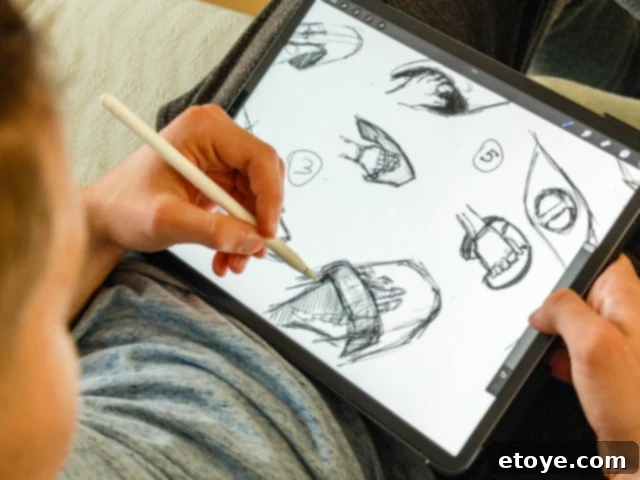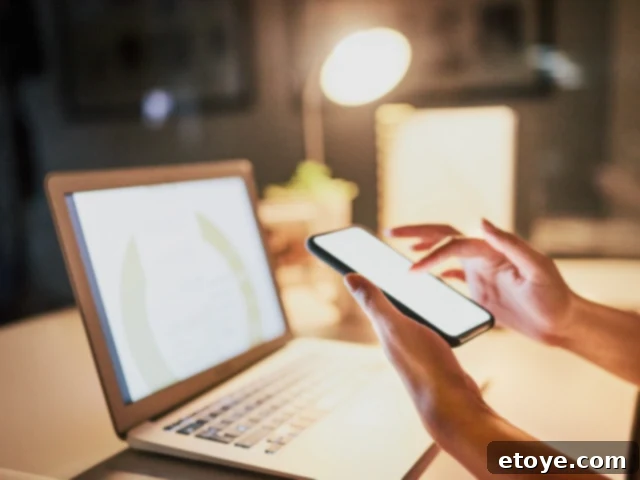Reclaiming Your Focus: Mastering Screen Time for Enhanced Mental Well-being
In our hyper-connected world, it’s all too easy to find ourselves trapped in the ubiquitous scrolling loop. That familiar scenario begins with a quick check of your phone, only to look up 45 minutes later, realizing you’ve achieved little more than passive consumption of digital content. Perhaps you’ve learned what a complete stranger had for brunch or gotten needlessly agitated by an online debate. The aftermath often involves a wave of guilt, pondering all the productive or restorative activities you could have engaged in instead: a refreshing walk, a meaningful conversation with a friend, delving into a captivating book, or simply allowing your mind to genuinely rest instead of bombarding it with endless, often meaningless, information. It’s a personal observation that excessive screen time isn’t just a drain on our precious hours; it subtly erodes our mental well-being, often without immediate notice.
However, the notion of a complete digital detox, a sudden and total unplugging, is largely unrealistic for most people in today’s landscape. Our lives—from professional obligations to social interactions and learning opportunities—are deeply intertwined with digital platforms. Attempting a drastic, cold-turkey approach often leads to frustration and failure by lunchtime. Instead, the real solution to mitigating the negative impacts of screens isn’t about abandoning them entirely. It’s about cultivating a smarter, more mindful approach to how we use our digital devices. When leveraged correctly, screens don’t have to be detrimental; surprisingly, they can even contribute positively to mental health and personal growth. This might sound counterintuitive given the common narratives surrounding screen time, but the distinction lies in conscious engagement versus passive consumption.

Screens Can Be Beneficial: Harnessing Technology for Good
The widespread belief that all screen time is inherently bad is a misconception. When utilized thoughtfully, digital platforms, video games, and even professional digital tools can foster genuine social interactions, unlock significant personal growth opportunities, and enhance cognitive functions. Consider, for instance, engaging in a cooperative online game with friends, where teamwork and communication are paramount. Or participating in a group video call to connect with loved ones living far away. These activities cultivate real social bonds and strengthen relationships, directly countering feelings of isolation often associated with screen overuse.
This positive engagement stands in stark contrast to “doomscrolling,” the act of endlessly consuming negative news or internet drama, which is indeed a fast track to heightened anxiety, low self-esteem, and depressive symptoms. The key differentiation lies in the intentionality and quality of the interaction. With the right mindset and clearly defined boundaries, screen time can lead to remarkable improvements in cognitive functions, such as problem-solving and critical thinking, and bolster social skills through diverse online communities.
Have you ever found solace or understanding in an online community centered around a shared hobby, challenge, or identity? That profound sense of belonging and validation is a testament to the powerful, positive impact digital platforms can have when used mindfully. Furthermore, screens offer unparalleled access to educational content, allowing individuals to learn new skills, languages, or academic subjects through online courses and tutorials. They also facilitate professional networking, mentorship, and career development, connecting people across geographical boundaries. For many, especially those with mobility challenges or living in remote areas, digital devices are indispensable tools for maintaining independence, accessing essential services, and staying connected to the world. Telehealth services and mental wellness apps, for example, provide crucial support, demonstrating how technology can directly contribute to better mental health outcomes.

Establishing Effective Screen Time Boundaries for Digital Well-being
One of the most effective strategies for preventing the adverse effects of excessive screen time is to establish, and rigorously adhere to, clear boundaries. While this advice may not be groundbreaking, its efficacy is undeniable. Implementing screen-free zones within your home—such as the dining table or your bedroom—can profoundly impact your sleep quality, interpersonal relationships, and overall mental health. When you refrain from screen use immediately before bed, you naturally avoid the disruptive blue light emitted by devices, which interferes with melatonin production and consequently, your ability to fall asleep and achieve restorative rest.
Identify specific digital platforms or applications that tend to monopolize your free time. Consider reducing or even eliminating mindless scrolling on these particular culprits. A successful approach for many involves limiting engagement to essential communication, such as messaging, on certain apps. However, even with this restriction, you might find it challenging to completely avoid content consumption, as a significant portion of modern communication involves sharing links, videos, and images. In such cases, further boundaries might be necessary, including politely asking friends and family to moderate the amount of content they send. This fosters a culture of conscious sharing rather than overwhelming digital input.
For those for whom going completely screen-free feels insurmountable—and let’s be honest, for most, it does—integrating regular, short breaks throughout the day is a highly practical and beneficial alternative. Even just five minutes spent standing, stretching, looking out a window at something other than a glowing screen, or simply closing your eyes can significantly reset your brain. Bonus points are awarded for incorporating any form of physical activity during these breaks, as movement further enhances cognitive function and reduces mental fatigue. These micro-breaks are crucial for preventing digital burnout and maintaining focus, allowing your mind to process information and return to tasks with renewed clarity.

Active vs. Passive Screen Time: A Crucial Distinction for Mental Health
It’s an easy pitfall to categorize all screen use under the umbrella of “unhealthy,” but this generalization overlooks a critical distinction: the difference between active and passive screen time. The former involves purposeful, engaging activities that stimulate cognitive functions and often lead to skill development or creative output. Examples include creating digital art, writing, learning a new language through an interactive app, collaborating on a project with colleagues, coding, or engaging in strategic online games that require problem-solving.
Passive screen time, conversely, is characterized by mindless consumption without significant mental engagement. This looks like endless scrolling through social media feeds, binging random YouTube videos or television series, or repetitively playing simple, unchallenging mobile games. The distinction is stark, and the impact on your brain and overall well-being is dramatically different. Spoiler alert: active screen time is overwhelmingly more beneficial for your mental health.
Recent research underscores this point. A study found that children who engaged in active screen time—such as using educational apps, creative software, or conducting online research—experienced fewer detrimental effects compared to those who spent equivalent hours consuming passive content. This finding is consistent with previous research indicating that children who use screens for interactive and cognitively stimulating activities tend to exhibit better academic performance, stronger cognitive development, and even improved mental health outcomes.
The fundamental difference lies in whether you are using a screen to create or to merely consume. When you are creating, your brain is actively engaged in problem-solving, critical thinking, imagination, and decision-making. This type of engagement fosters a “flow state,” where you become deeply absorbed in the task, leading to feelings of accomplishment and satisfaction. In contrast, passive consumption, while offering momentary distractions or dopamine hits from novelty, is linked to a higher likelihood of developing low self-esteem, experiencing increased mental health challenges, and suffering from poor sleep quality due to reduced mental stimulation and increased mental fatigue. Actively engaging with screens can be a powerful tool for personal growth and learning, transforming a potential time sink into a valuable resource for intellectual and creative development.

Practical Strategies to Limit Screen Time and Boost Well-being
Mindful screen use is not about an abrupt, radical detox, but rather about taking conscious control over your digital habits. Instead of passively allowing hours to vanish into aimless scrolling, you can actively engage with digital devices in ways that genuinely benefit your brain, elevate your mood, and support your overall mental well-being. The core principle is to pivot from thoughtless consumption to meaningful engagement, and to intentionally swap a portion of your screen time for healthier, more enriching habits. Here are actionable strategies to achieve this balance:
Cultivate a “To-Do” List for Screen-Free Moments
Let’s be candid: a significant portion of our impulse to grab our phones isn’t driven by genuine necessity, but rather by momentary lulls in our day when we feel unsure of what else to do. This is precisely where a pre-prepared list of alternative activities becomes invaluable. Jot down a handful of productive, fulfilling, or simply enjoyable things you could or should be doing. Keep this list readily accessible—perhaps on your desk, affixed to the refrigerator, or even within your notes app. When the familiar urge to mindlessly scroll arises, consult your list. Your options could range from tasks you’ve been procrastinating on, such as organizing a drawer or sending an email, to simple pleasures like reading a chapter of a book, tending to your houseplants, calling a loved one, or even planning your next meal. This proactive approach transforms idle moments into opportunities for constructive engagement.
- Why it works: Creating a go-to repertoire of screen-free activities actively disrupts the autopilot habit of reaching for your phone. It serves as a powerful reminder that there are numerous satisfying and enriching alternatives to passive digital consumption, empowering you to make more conscious choices with your time and energy.
Transition from Passive Scrolling to Creative Engagement
Instead of zoning out on social media feeds, intentionally redirect your screen time toward activities that actively engage your brain and foster creativity. Embrace digital drawing or painting, delve into creative writing projects, learn a new skill through an interactive app (like coding or music production), or explore graphic design. By doing so, your screen transforms from a potential source of low self-esteem or endless comparison into a potent tool for personal growth, skill acquisition, and imaginative expression. These activities demand focus, problem-solving, and often result in a tangible sense of accomplishment.
- Why it works: Engaging in creative tasks on screens stimulates cognitive development, enhances problem-solving abilities, and generally leads to improved mental health outcomes. The sense of achievement derived from creating something far surpasses the fleeting satisfaction of a random TikTok binge, contributing to a more positive self-perception.
Substitute Screen Time with Invigorating Physical Activities
While a modicum of digital entertainment is harmless, excessive screen time is often synonymous with a sedentary lifestyle, which can gradually erode physical and mental health. The next time you find yourself inexplicably glued to a screen, consciously decide to step away and initiate some form of movement. This could be as simple as a brisk walk around the block, a series of stretches, a quick home workout, or even some vigorous cleaning. Incorporating more movement into your day directly counteracts the negative physiological effects of prolonged sitting.
- Why it works: Physical activities are incredibly effective at improving sleep patterns, significantly reducing stress levels, and combating the risks associated with a sedentary lifestyle that frequently accompanies high screen time. Even light physical activity triggers the release of endorphins, helps to reset your brain, boosts your mood, and enhances overall cognitive function, leaving you feeling more energized and focused.
Designate Sacred Screen-Free Zones
Consciously establish specific areas within your home where screens are strictly off-limits. Prime examples include the dining table, where family meals can become opportunities for genuine conversation, or your bedroom, which should be reserved for rest and intimacy. This deliberate creation of screen-free sanctuaries naturally encourages more face-to-face interactions with household members, fostering stronger relationships. Critically, it also aids in establishing a proper wind-down routine before bedtime, promoting superior sleep hygiene.
- Why it works: Banning screens from certain spaces dramatically improves sleep quality by eliminating disruptive blue light exposure before bed. Moreover, it significantly enhances your social connections by creating dedicated environments that encourage present, in-person interaction, thereby reducing feelings of social isolation that can arise from excessive digital interaction.
Prioritize Essential Tasks Before Engaging with Screens
Adopt the habit of completing your most important tasks for the day before indulging in your favorite show, game, or social media scroll. Whether these involve academic assignments, preparing meals, responding to crucial emails, or a brief cleaning session, getting these priorities out of the way first ensures that you can then enjoy your screen time without the nagging burden of procrastination or guilt. This approach aligns with productivity principles and enhances your sense of control over your day.
- Why it works: Prioritizing important activities ensures that your energy and attention are first directed towards what truly matters, which inherently helps to reduce anxiety and significantly boosts your sense of accomplishment and self-efficacy. This also makes your leisure time feel more earned and enjoyable.
Embrace and Engage in Diverse Screen-Free Leisure Activities
Remember that screens are not the exclusive gateway to relaxation or entertainment. Actively integrate a variety of screen-free activities into your daily and weekly routines. Consider delving into a good book, engaging in board games or puzzles with friends and family, picking up a hands-on hobby that doesn’t involve a glowing rectangle (e.g., knitting, gardening, playing a musical instrument, cooking a new recipe), or simply spending time in nature. Explore new interests that stimulate your senses and creativity offline.
- Why it works: Diversifying your leisure time is crucial for reducing potential social isolation and mitigating the mental health challenges often linked to over-reliance on screens. Furthermore, engaging in tactile, creative, or physical activities provides a refreshing mental break and a different kind of fulfillment after hours spent staring at a screen, offering a more holistic approach to rest and recreation.

Navigating Life Among the Screens: A Path to Digital Wellness
The undeniable reality is that screens are an integral and permanent fixture of modern life. In today’s digital age, they are as ubiquitous as your morning coffee or the occasional frustration over sluggish Wi-Fi. It’s futile to wish them away, but it’s entirely within our power to reshape our relationship with them. By embracing intentionality and mindfulness in how we engage with our digital devices, we can effectively sidestep the myriad negative effects while simultaneously capitalizing on their immense benefits for connection, learning, and creativity.
The journey to digital well-being is not about perfection, but about progress. It’s about making conscious choices, experimenting with boundaries, and cultivating habits that truly serve your mental and emotional health. Each small step towards more mindful technology use contributes to a more balanced and fulfilling life in this screen-dominated era. It’s an ongoing process of self-awareness and adjustment, recognizing that our digital habits are dynamic and require continuous evaluation.
Now, if you’ll kindly excuse me, I’m off to put my “strategic screen use” theory to the test by logging off for an hour. Or perhaps ten minutes. Baby steps, after all, are still steps in the right direction.
Have you discovered successful strategies for reigning in your screen time? Do you have any unique tips or insights to share that have improved your digital well-being? We would genuinely love to hear your experiences and advice in the comments below. And once you’ve shared, remember to take a moment to truly relax without your phone or other digital devices nearby!
